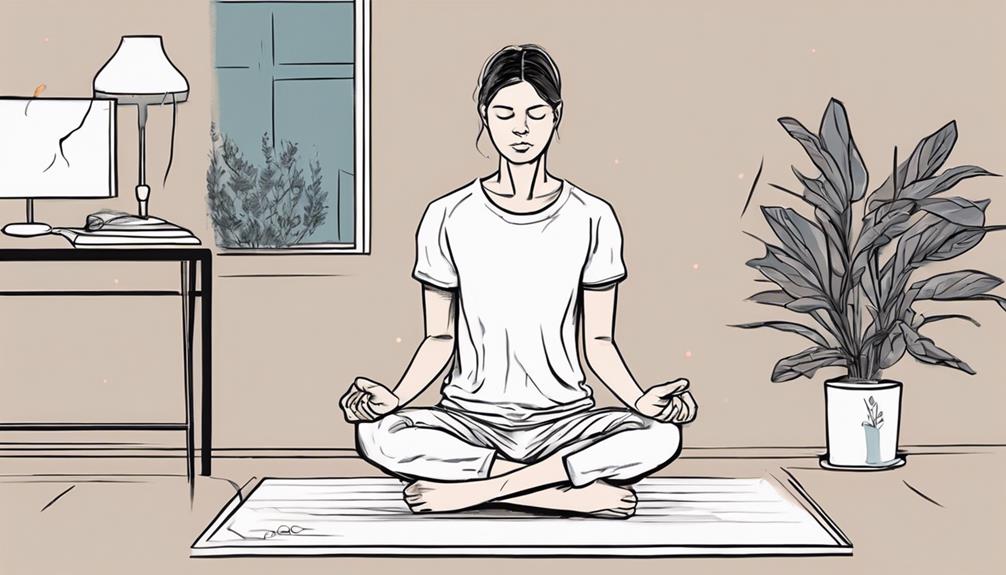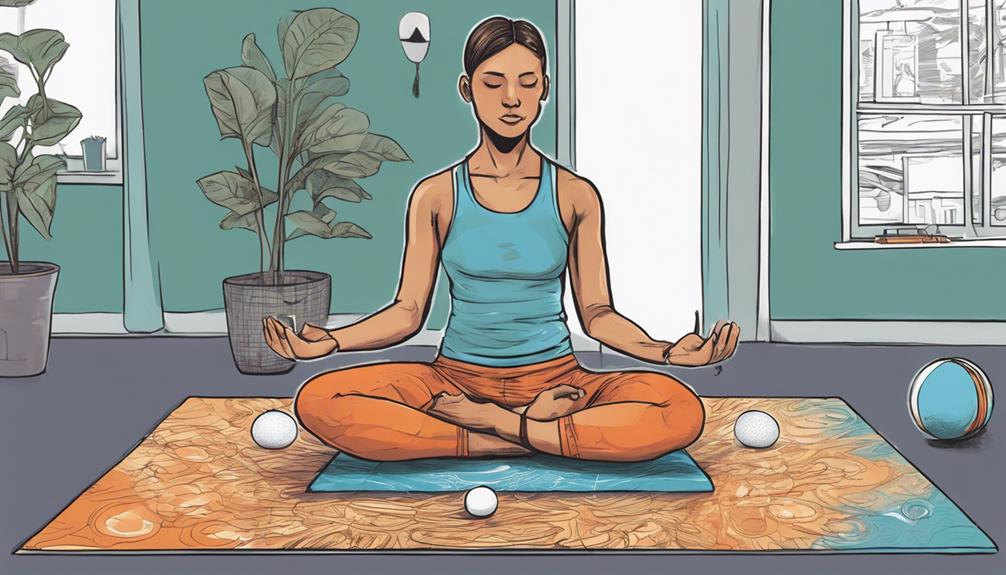At home, you can engage in somatic therapy by utilizing grounding techniques, breathing exercises, body scans, emotional regulation strategies, trauma management techniques, and mindfulness exercises to boost your mental health. Begin with techniques like mindful breathing, body scans, gentle yoga, muscle relaxation, and grounding methods. Set up your practice space with a yoga mat, comfortable clothing, and a quiet environment. Importance lies in regular practice for short durations, having patience, setting achievable goals, and seeking professional advice when necessary. These practices can heighten your awareness of self, increase your resilience, and support comprehensive healing. Exploring further information on techniques and tools for somatic therapy will aid your progress.
Key Takeaways
- Engage in grounding and breathing exercises for self-regulation.
- Use body awareness techniques like body scans and movement.
- Create a safe space for emotional regulation and trauma management.
- Practice mindfulness and vagal nerve stimulation at home.
- Utilize somatic therapy tools like yoga mats and comfortable clothing.
Grounding Techniques for Home Practice
To practice grounding techniques for somatic therapy at home, engage in activities like running water over your hands, doing deep breathing exercises, and conducting body scans. These techniques are essential for managing trauma triggers, reducing anxiety, and dealing with flashbacks effectively. By incorporating grounding exercises into your daily routine, you can enhance emotional stability, improve self-regulation, and boost overall well-being.
When you feel overwhelmed or encounter triggers that bring up past traumas, grounding techniques can help you stay present and calm. Simple activities like focusing on your body sensations or playing mental games can be powerful tools for managing anxiety and stress in the comfort of your home. By practicing these techniques regularly, you empower yourself to navigate challenging emotions and situations with greater ease.
Whether you're dealing with PTSD symptoms or seeking to regulate your emotions, grounding exercises offer a practical and accessible way to support your mental and emotional health independently. Remember, consistency is key in building resilience and coping skills through home-based somatic therapy practices.
Resourcing and Visualization Techniques

Engage in resourcing and visualization techniques to enhance emotional regulation and stability in somatic therapy. Resourcing techniques aim to create a secure space within yourself, countering distressing sensations with comforting ones. These methods can be particularly beneficial for managing trauma symptoms such as anxiety, stress, and dissociation.
Visualization exercises, on the other hand, involve focusing on positive mental imagery to help alleviate distress and promote a sense of serenity.
While practicing these somatic therapy techniques at home can be valuable, it's crucial to remember that they're best learned under the guidance of a trained mental health professional. This not only guarantees the safety but also the effectiveness of these techniques.
Somatic Exercises for Mental Health

You can start incorporating somatic exercises into your daily routine to improve your mental well-being.
These exercises, such as grounding techniques, body scans, and breathwork, can help you manage stress and enhance self-awareness.
Home Somatic Exercise Benefits
Practicing somatic exercises at home offers significant benefits for enhancing mental health, including grounding, stress reduction, and trauma processing. These exercises aid in emotional regulation, resilience building, and overall well-being.
By engaging in somatic exercises regularly, you can improve your body awareness, regulate breathing, and promote relaxation in the comfort of your own space. Home somatic exercises encompass body scans, breathwork, movement techniques, and grounding exercises tailored for mental health enhancement.
Such practices not only complement professional therapy but also support ongoing mental health maintenance. Taking the time to engage in somatic exercises at home can help you feel more grounded, reduce stress levels, and process trauma in a safe and familiar environment.
DIY Mental Health Techniques
To enhance your mental health through somatic exercises at home, consider incorporating grounding techniques like body scans and focused walks. Body scans help you tune into each part of your body, promoting awareness and relaxation.
Focused walks encourage mindful movement, connecting your physical and mental states for overall well-being. Additionally, practicing breathing exercises can help regulate emotions and reduce stress levels. By focusing on deep, intentional breaths, you can calm your nervous system and center yourself in the present moment.
Posture checks are another valuable tool in somatic therapy; maintaining good posture supports a positive mindset and physical health. Engaging in natural body movements, such as stretching or gentle yoga, can release tension and increase body awareness.
These simple yet effective somatic techniques can be easily incorporated into your daily routine, promoting mindfulness and enhancing your mental health.
Practical Self-Care Strategies
Grounding exercises and simple movements can be effective strategies for enhancing mental health through somatic exercises at home. By focusing on physical sensations and body awareness, somatic exercises can aid in regulating the nervous system and supporting trauma treatment. Body scans, breathwork, and practices like walking or running water over your hands can help you connect to the present moment and manage triggers from past experiences.
Posture exercises, yoga, and mindfulness techniques are valuable tools to release tension stored from traumas and improve emotional regulation. Engaging in vagus nerve exercises can further promote relaxation and overall well-being. Remember, creating a personalized somatic therapy routine with resourcing and visualization techniques can empower you to take charge of your mental health journey.
Mindfulness and Vagus Nerve Exercises

By incorporating mindfulness techniques like diaphragmatic breathing and progressive muscle relaxation, you can effectively regulate your vagus nerve for improved emotional well-being. These practices help reduce nervous tension and promote relaxation, benefiting your overall mental health.
Additionally, engaging in cold exposure techniques or activities like humming and chanting can also stimulate the vagus nerve, further aiding in stress reduction and emotional regulation. Positive social interactions play a pivotal role in activating the vagus nerve, fostering a sense of connection and well-being.
Exploring these methods to stimulate the vagus nerve can support your somatic therapy efforts at home, assisting in trauma recovery and stress management. Remember, incorporating these exercises into your daily routine can have a significant impact on your emotional well-being and resilience.
Trauma Management Strategies

Exploring trauma management strategies involves incorporating various somatic exercises and mindfulness techniques to support emotional regulation and stress reduction at home.
When dealing with traumatic experiences, grounding techniques such as body scans and breathwork can help manage overwhelming emotional responses in a safe manner.
By practicing resourcing and visualization techniques, you can create a secure internal space that fosters emotional regulation during times of distress.
Engaging in somatic exercises like yoga or simple body movements provides a physical outlet for processing trauma and promoting relaxation.
Additionally, mindfulness techniques and vagus nerve exercises play an essential role in calming the nervous system and reducing stress levels associated with past traumas.
Together, these trauma management strategies offer practical ways to address and cope with the effects of traumatic events from the comfort of your own home.
Somatic Memory Processing Methods

You can start processing somatic memories by engaging in memory techniques that help release stored trauma energy in your body.
Try incorporating practices such as body scans, breathwork, and movement into your daily routine to integrate past traumas and reduce their impact on your present life.
Memory Processing Techniques
Somatic memory processing techniques offer effective ways to address how traumatic memories are stored in the body. Engaging in practices like body scans, mindfulness techniques, and yoga can aid in processing somatic memories. These methods focus on integrating physical sensations with emotional experiences, allowing individuals to work through past traumas effectively.
Body scans: By directing attention to different parts of the body, individuals can become more aware of physical sensations associated with traumatic memories.
Mindfulness practices: Being present in the moment and observing thoughts and sensations without judgment can help in acknowledging and processing somatic memories.
Yoga: Through movement and breathwork, yoga can release tension held in the body from past traumas, promoting healing and integration of somatic memories.
Somatic experiencing therapy is another valuable approach that can assist in releasing trapped energy from traumatic events, ultimately aiding in the healing process. These techniques provide individuals with tools to address and overcome the impact of past traumas stored in the body.
Home Somatic Practices
Home somatic practices offer effective ways for you to address symptoms related to trauma and release trapped energy stored in your body from past traumatic events. These practices include body scanning, grounding exercises, breathing exercises, and body movement techniques.
Body scanning involves focusing on different parts of your body to identify tension and release it, aiding in the processing of somatic memories. Grounding exercises help you connect with the present moment, promoting a sense of safety and stability.
Breathing exercises can regulate emotions and reduce anxiety by activating the body's relaxation response. Body movement techniques, such as gentle stretches or yoga, can help release physical tension and promote a sense of well-being.
Holistic Treatment Plans Overview

Holistic treatment plans in somatic therapy thoroughly address an individual's mental, physical, and emotional well-being through tailored strategies and integrated therapeutic modalities. These plans are personalized to cater to each person's specific needs, encompassing a range of approaches to promote holistic healing and resilience.
- Somatic Exercises: These exercises are designed to help individuals reconnect with their bodies, release tension, and enhance body awareness as part of the healing process.
- Mindfulness Techniques: Incorporating mindfulness practices can aid in grounding oneself, managing stress, and fostering a deeper connection between the mind and body.
- Emotional Regulation Strategies: By learning effective techniques to regulate emotions, individuals can build emotional resilience, improve self-awareness, and cultivate healthier coping mechanisms for everyday challenges.
Holistic treatment plans often emphasize self-care practices, self-compassion, and the development of emotional resilience to support sustained well-being and personal growth.
Somatic Therapy Techniques Explained

Exploring techniques in somatic therapy can provide valuable insights into how to address trauma-related physical sensations effectively.
Body scanning is a technique where you focus on each part of your body, paying attention to any tension or discomfort.
Grounding exercises help you connect with the present moment by focusing on your surroundings, which can be particularly useful during moments of distress.
Incorporating breathwork into your somatic therapy practice can help regulate emotions and calm the nervous system.
These techniques aim to release trapped energy in the body that may be contributing to feelings of anxiety or unease.
By engaging in somatic therapy exercises at home, you can work towards restoring the mind-body connection and promoting healing from within.
Practicing these techniques regularly can empower you to take an active role in your emotional well-being and address trauma-related physical sensations in a holistic manner.
Emotional Regulation Practices

To effectively manage and process intense emotions, somatic therapy emphasizes the importance of implementing emotional regulation practices. In somatic therapy, emotional regulation techniques play an essential role in helping individuals stabilize their emotions in the comfort of their homes.
Here are some key practices you can incorporate into your routine:
- Containment exercises: These exercises involve visualizing a safe space where you can contain overwhelming emotions, allowing you to address them at a pace that feels manageable.
- Resourcing: Utilize resourcing techniques to connect with positive memories, supportive figures, or soothing sensations that can provide comfort during times of emotional distress.
- Grounding techniques: Grounding exercises focus on connecting with the present moment through sensory experiences, such as deep breathing or focusing on physical sensations, to anchor yourself during emotional turbulence.
Holistic Healing Through Somatic Therapy

Explore self-care practices, emotional wellness tools, and holistic healing benefits through somatic therapy.
Discover how somatic techniques can help you cultivate a deeper mind-body connection, release stored tension, and enhance your overall well-being.
Self-Care Practices
Holistic healing through somatic therapy emphasizes the importance of incorporating self-care practices to nurture mental and emotional well-being. Self-care practices within somatic therapy play a vital role in promoting emotional release, fostering holistic healing, and enhancing one's overall well-being.
Here are three essential self-care practices recommended in somatic therapy:
- Journaling for Emotional Release: Engaging in regular journaling sessions can help you express and process your emotions, leading to a sense of release and empowerment.
- Practicing Self-Love: Embracing acts of self-love is fundamental in somatic therapy, as it cultivates a positive self-image and nurtures a compassionate relationship with oneself.
- Enhancing Mental Well-Being: Through somatic therapy, prioritizing self-care practices that support mental well-being, such as mindfulness exercises and relaxation techniques, can contribute to emotional resilience and holistic healing.
Incorporating these self-care practices into your daily routine can greatly impact your emotional wellness and support your journey towards holistic healing through somatic therapy.
Emotional Wellness Tools
Emotional regulation and resilience are key focuses in holistic healing through somatic therapy. Somatic therapy offers various tools to support emotional well-being, such as containment exercises and resource techniques. Containment exercises help individuals create a safe internal space to process overwhelming emotions, while resource techniques assist in accessing positive memories or sensations to cultivate inner strength.
Additionally, integrating interoception practices into somatic therapy enhances the mind-body connection, promoting a deeper understanding of one's emotions and physical sensations. By engaging in sensory tracking and self-awareness techniques, individuals can develop a heightened sense of self-awareness, leading to improved emotional regulation and overall well-being.
Holistic Healing Benefits
To fully grasp the benefits of holistic healing through somatic therapy, understanding the profound impact of integrating physical, emotional, and mental aspects is pivotal. Holistic healing through somatic therapy emphasizes the importance of the mind-body connection in promoting overall well-being.
By incorporating somatic therapies, individuals can tap into the interconnectedness of their body sensations and emotions, fostering all-encompassing healing. Here are some key benefits of holistic healing through somatic therapy:
- Enhances self-awareness and emotional regulation.
- Promotes self-care practices for overall well-being.
- Utilizes exercises to help in strengthening the mind-body connection.
Through these practices, individuals can experience a deeper sense of self-awareness and resilience. Incorporating somatic therapy into daily routines at home can be a powerful tool in enhancing overall wellness and promoting holistic healing.
Frequently Asked Questions
Can You Do Somatic Therapy by Yourself?
Yes, you can do somatic therapy by yourself. It may be challenging without guidance. Utilize resources like books or online videos. Create a safe space at home. Consistent practice can help manage stress, anxiety, and trauma symptoms.
What Is the Most Effective Somatic Technique?
For the most effective somatic technique, investigate grounding exercises, body scanning, and breathwork to nurture mind-body harmony. Delve into somatic experiencing methods like pendulation and rhythmic movement to process trauma triggers effectively.
Can You Do Somatic Therapy Online?
You can definitely do somatic therapy online. Trained therapists offer virtual sessions tailored to your needs. They guide you through exercises to manage trauma and stress. Access professionals specializing in somatic healing practices from home.
Do Somatic Workouts Actually Work?
Yes, somatic workouts do work. They effectively calm the nervous system, enhance emotional regulation, and promote mind-body connection. Regular practice can reduce anxiety, stress, and symptoms of PTSD, improving mental health and resilience.
Conclusion
Now that you have the tools and techniques for somatic therapy at home, it's time to take control of your mental health journey.
By incorporating grounding techniques, somatic exercises, and mindfulness practices into your daily routine, you can actively work towards healing and emotional regulation.
Remember, holistic healing is within your reach right in the comfort of your own home.
Start implementing these strategies today and see the transformation unfold before your eyes.









